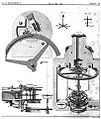Pierre Le Roy
Pierre Le Roy (* 1717 in Paris , † 1785 in Vitry-sur-Seine ) was one of the most important French watchmakers and inventors . Together with Ferdinand Berthoud , Le Roy was a leader in the development of the chronometer escapement . He created a temperature compensation by a bimetal - balance with adjustable weight screws and the isochronous balance spring . His developments created the basis for today's mechanical chronometers .
Le Roy was born in Paris as the son of Julien Le Roy (1686–1759), who was the court watchmaker of Louis XV. and had worked with Henry Sully .
Invention of the chronometer escapement
In 1748, Le Roy invented the first form of the free escapement. In addition to chronometers, he also manufactured stopwatches , but his greatest successes were in the construction of marine chronometers . Like John Harrison , he worked on improving the seaworthiness of marine chronometers, which he achieved by decoupling the escapement and balance wheel. He also first introduced the use of bimetal tires for the balance. His method of temperature compensation allow the change of gear without changing the spiral length because he had found that an isochronous balance spring has only one optimal length that he therefore did not want to change. This length is characterized by the fact that the frequency is independent of the amplitude , which means that mechanical watches run smoothly, regardless of the varying drive from the barrel .
Development of the modern marine chronometer
After initial drafts in 1754, Le Roy built his first chronometer in 1756. He continued the technical development of his chronometers until 1766, when he designed a watch with a free escapement, temperature-compensated balance and isochronous balance spring, which today forms the basis of mechanical marine chronometers. The accuracy was comparable to that of the John Harrison H4 chronometer .
In 1769, Le Roy received the Académie française double prize for the best method of measuring time at sea. This success was based, among other things, on the isochronous balance spring, for which it was in competition with Ferdinand Berthoud , but which Le Roy was able to publish first. He was also the specialist author of several writings on watchmaking and chronographs, including Étrennes chronométriques from 1760, and in 1760 also became a royal watchmaker.
However, his work was less valued in France than that of his contemporary Ferdinand Berthoud , who was awarded the title of Horloger de Marine (marine watchmaker). Le Roy then retired.
photos
Description of the Le Roy chronometer escapement by the Académie des Sciences , dated August 14, 1748
Pierre Le Roy chronometer, 1766, Musée des arts et métiers
literature
- Auguste Jean Dorange: Notice on Julien Le Roy, horloger . Éditions Rouillé-Ladevèze, Tours 1880, p. 3.
Web links
Individual evidence
- ^ GH Baillie: Watchmakers & Clockmakers of the World. Third Edition, NAG Press Ltd., London 1966.
- ^ A b c Samuel L. Macey: Encyclopedia of time p.348
- ↑ Britten's Watch & Clock Makers' Handbook Dictionary & Guide, Fifteenth Edition, p.122
- ^ A Journal of natural philosophy, chemistry and the arts, p.159
- ↑ a b c d e f Lance Day, Ian McNeil: Biographical dictionary of the history of technology , p. 429
| personal data | |
|---|---|
| SURNAME | Le Roy, Pierre |
| BRIEF DESCRIPTION | French watchmaker, inventor |
| DATE OF BIRTH | 1717 |
| PLACE OF BIRTH | Paris |
| DATE OF DEATH | 1785 |
| Place of death | Vitry-sur-Seine |




